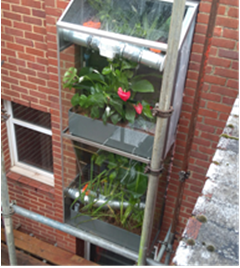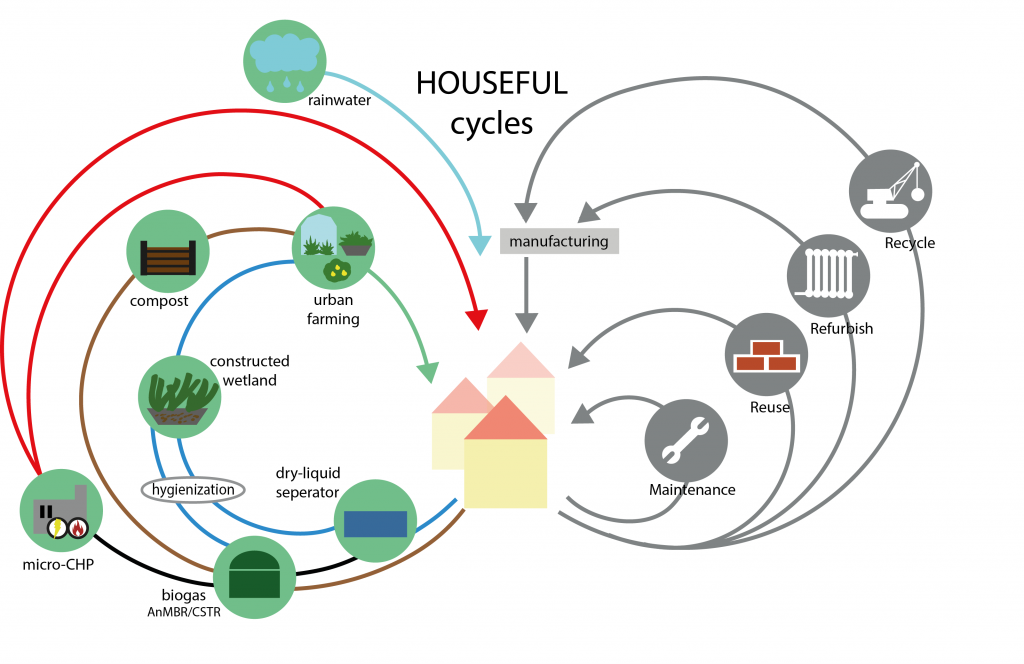ReCO2ST is an EU Horizon 2020 research program aiming to better building & living. It applies an easy 3-step approach to building renovations, resulting in major savings and heightened standards of living, at a near-zero energy coefficient.
First, our interactive Refurbishment Assessment Tool (RAT) provides the customer with clearly defined, user-driven refurbishment scenarios. The installation is then planned and optimized through an Integrated Project Delivery (IPD) tool, and finally, the selected refurbishment package of innovative technologies is deployed as a customizable Retrofit-Kit. The Retrofit-Kit features a compendium of cost efficient and modular technologies, including: Vacuum Insulation, Modular Photovoltaics, Smart Windows for Heating and Cooling, an Intelligent Energy Management System, fully integrated Wireless Sensor Network, Cool Materials and Nature Based Solutions.
The technologies have been chosen based on their cost effectiveness, energy use and generation efficiency, reliability and applicability in a wide range of building types. End user will be empowered to take an informed decision regarding the renovation extent followed by principles of Integrated Project Delivery (IPD) leading to the final selection of the technologies to be installed. At least five of the ReCO2ST components will be required to ensure the advantages provided by the method (Hard Constraints). There is however choice in terms of model, system, technology etc.
Cost & Time Efficiency:
- Modular Action Plans with Adaptable Solutions
- Integrated Project Delivery
- Least Cost Approach
- Synergies between Technologies
- Predictive Maintenance
Energy Efficiency:
- Ultra-Thin Vacuum Insulation
- Compact PV Arrays (Photovoltaics)
- Smart windows
- Cooling Materials
- System monitored & Controlled by Building Energy Management Systems (BEMS)
Human Health & Comfort:
- Thermal, Acoustic and Visual Comfort
- Passive on Demand Ventilation
- Nature Based Air Treatment
- Streamlined and Intuitive Integrated Environmental Management Systems (IEM) Optimized for Indoor Environmental Quality (IEQ)
Environment:
- Urban Microclimate Improvement
- Renewable Energy Sources (RES) Energy Generation
- Low CO2 Footprint of Solutions
- Decarbonized Refurbishment

RECO2ST Results
As specialists in the nature-based solutions, alchemia-nova has developed two automatable bio-technical indoor air-treatment systems for inclusion in the Retrofit-Kit. The systems are based on the air purification, cooling and humidification properties of specially selected plants. They improve indoor air quality and thermal comfort by filtering out harmful Volatile Organic Compounds (VOCs) and Particulate Matter (PM), and by regulating relative humidity levels, enhancing also significantly the aesthetics of the indoor environment. The first comprises of a decentralised pot-plant-based system (AeroPlant) easily installed into buildings as part of a retrofit-kit, or as stand-alone solutions. The second system (Casetta) is a semi-centralised unit that can be installed in a window, in which ambient-air is treated by directing ventilation through a “winter garden”-like plant chamber.

Casetta Brunel

AeroPlant kitchen integrated
The systems are automatable and designed to maintain better and healthier air-quality, and a stable indoor temperature, heightening comfort and significantly enhancing the aesthetics of the indoor environment.
Download the Aeroplant Leaflet


Project coordinator
AALBORG UNIVERSITET, Denmark
Project Partners
BRUNEL UNIVERSITY LONDON, United Kingdom
UNIVERSITY COLLEGE CORK – NATIONAL UNIVERSITY OF IRELAND, Ireland
UNIVERSIDAD DE CADIZ, Spain
ESTIA SA, Switzerland
VA-Q-TEC AG, Germany
GROUPE E GREENWATT SA, Switzerland
QUANTIS, Switzerland
ALCHEMIA-NOVA GMBH, Austria
HORN IRENE, Denmark
CORE INNOVATION AND TECHNOLOGY OE, Greece
FREDERIKSHAVN BOLIGFORENING, Denmark
UNITED TECHNOLOGIES RESEARCH CENTRE IRELAND LIMITED, Ireland
ACCIONA CONSTRUCCION SA, Spain
AYUNTAMIENTO DE CADIZ (ADCADIZ), Spain
RETRAITES POPULAIRES (RP), Switzerland
EUROPEAN COOL ROOFS COUNCIL (ECRC), Belgium
Project status
Starts 1/2018, duration 42 months
Project homepage: www.recost.eu
Call: H2020-EEB- 005-2017 Development of near zero energy building renovation
Innovation Action
Grant Agreement Number: 768576
Estimated Project Cost: € 8,415,618.75
Requested EU Contribution: € 6,914,690.00










